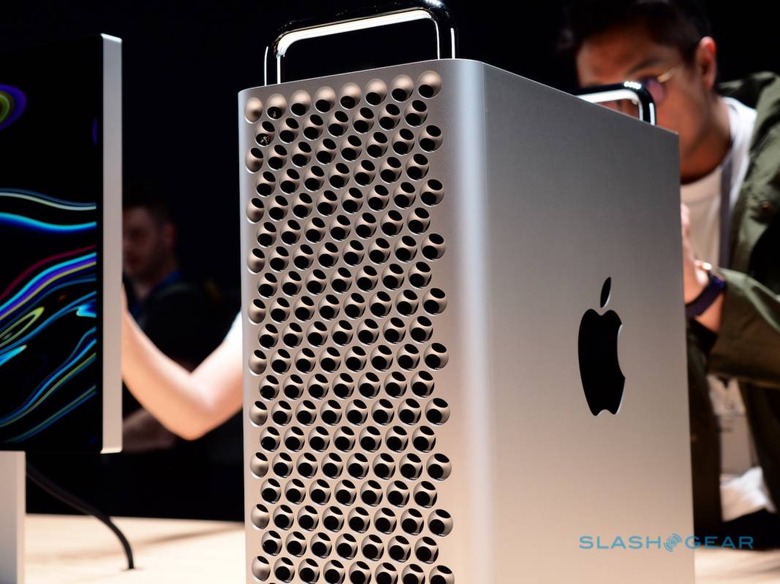How Apple Has Reacted To The Trade War
Apple may be the pride of America, but there's no avoiding the ironic fact that a "Assembled in China" stamp sits at the bottom of most Apple products. As much as the Trump Administration would like to eject American corporations from manufacturing in China, U.S. companies have their knees deep in Chinese partnerships. The iPhone has many parts sourced from China. Its screen, processor, glass and cameras all have sources in China.
This makes it extremely tough on national companies that now bear the weight of rising tariffs on Chinese goods. Currently, $300 billion of Chinese products are being taxed. President Donald Trump wishes to see Apple shift its manufacturing facilities to home soil, but given the higher costs it would lead to, is any of this even feasible?
Bringing Apple home
Right now, the Mac Pro is the only Apple product assembled in the United States. It is being held as a prime example of U.S. manufacturing – one the Trump Administration hopes to see more of. The Mac Pro was a bit of an experiment for Apple, using a "low-risk" product to test how successfully build it locally, according to The Wall Street Journal.
Production in Austin, Texas quickly met with supply issues. They had problems locally sourcing components for the Mac Pro, leading to delays. And soon the inevitable: They were brought back to China for parts (cue Thanos memes).

Unlike the U.S., manufacturers in China had the workers and cost-efficiency to keep up with demands. It was clear that producing a popular product like an iPhone on home ground was near impossible for Apple. But now hit with tariffs, China, the U.S.' go-to manufacturer, is giving Apple another headache.
These tariffs threaten to bring the prices of iPhones up by over $40 due to costs, which could even make Apple die-hards think twice about that upgrade.
Faced with this difficult reality, Apple's had to work around rising costs and pressure to bring jobs home. And this is how they've responded.
Shift to services
When you think of Apple, you think of iPhones and MacBooks. But this might not be true for much longer. Since product manufacturing would drive up costs this much, Apple quickly decided to put its eggs into a new market: services. These include Apple Music, Apple TV, iCloud storage, News and Arcade.

Apple Services are growing steadily. They hit "all-time high" services revenue this quarter, fetching $11.5 billion, which makes for over 20% of their Q3 revenue. Two years ago, this figure was $7.3 billion.
Most of these come with subscription models, which provide a reliable stream of revenue for Apple while they offer music, movies and other content at fairly low costs.
Imagine just how economical it is for Apple to refocus to Services – these come at a relatively low cost to Apple, without any manufacturing woes and brings jobs back to the U.S.
It's likely to be a reason why Apple is able to bring prices down $50 for the iPhone 11 to $699 – money now comes from other areas that far outweigh the money lost in cutting prices. Suddenly, despite the tariffs and falling iPhone sales, things are looking up for Apple.
Moving out of China
Billions of dollars in cost are still at stake if Apple sits still in China. When tariffs kick in this December, prices across all of Apple's products would inevitably shoot up. That $400 Google Pixel would look a lot more appealing.
Apple has set its eyes on India. Many Apple products have been manufactured in Indian factories, including parts of the iPhone X, iPhone SE and 6S. India has the advantage of lower-cost labour, but its national policies are making Apple think twice.
Protectionist policies in India tax electronic MNCs in India 20%, which would be a painful blow to any tech giant hoping to shift into India. Apple and the Trump Administration have been in talks with Indian government, hoping to ease tariffs and create an opening for Apple.
Barriers to entry among consumers are also surprisingly high. Unlike many markets, Apple held a dismal 1.2% market share in India, with Chinese and Asian brands gaining more popularity in its smartphone market. Apple have campaigned hard to create greater awareness and favor, including its "Made in India" campaign, but changing public perception will surely take time.
A call needs to be made quick too. Shifting its main manufacturing facilities across nations is no easy feat, with its colossal ecosystem of logistics and components built up in China.
The Verge reported moving out will probably take 18 months at a minimum, with results expected to emerge only after two years.
Meanwhile, tariffs are set to kick in this December.
